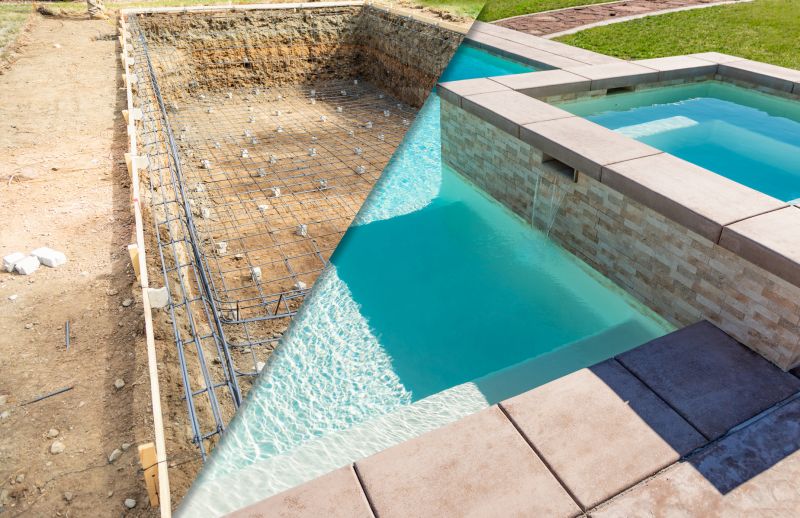Top Products For Swimming Pool Ground Levelings To Ensure Perfect Surfaces
Explore the leading solutions designed to create smooth, stable, and durable pool surroundings for a flawless swimming experience.
 Maintaining a level surface around a swimming pool is essential for safety, aesthetics, and proper water circulation. Ground leveling products are designed to address uneven terrain, fill in low spots, and create a stable base for pool installation or renovation. These products come in various forms, including powders, mixes, mats, and mats with embedded leveling agents, each suited to different types of ground conditions and project scopes. Selecting the right product can help ensure a smooth, durable surface that supports the pool structure and minimizes maintenance issues over time.
Maintaining a level surface around a swimming pool is essential for safety, aesthetics, and proper water circulation. Ground leveling products are designed to address uneven terrain, fill in low spots, and create a stable base for pool installation or renovation. These products come in various forms, including powders, mixes, mats, and mats with embedded leveling agents, each suited to different types of ground conditions and project scopes. Selecting the right product can help ensure a smooth, durable surface that supports the pool structure and minimizes maintenance issues over time.
Types of Products For Swimming Pool Ground Levelings
Ready-Mix Concrete
Pre-mixed concrete formulations designed for quick application and durable leveling surfaces around pools.
Polymer-Based Mixes
Flexible, binding mixes that adapt to ground movement and resist cracking over time.
Sand-Based Blends
Sand mixes combined with stabilizers for filling low spots and creating a firm base.
Crushed Stone or Gravel
Natural aggregates used for foundational support and drainage around pool areas.
Self-Leveling Mats
Flexible mats with embedded leveling agents that conform to ground contours for quick setup.
Polymer Mats with Fillers
Mats infused with leveling fillers for easy installation and stable surfaces.
Hydraulic Fillers
Water-activated products that expand and settle into uneven ground for stabilization.
Epoxy or Resin Coatings
Protective coatings that can be applied over leveled surfaces for added durability.
Vapor Barrier Films
Plastic sheets used beneath leveling products to prevent moisture infiltration.
Polyurethane Foam
Expanding foam used for filling voids and creating a smooth base.
Cementitious Patches
Patch compounds for repairing and leveling small areas around pools.
Polymer Soil Stabilizers
Additives that bind soil particles, improving ground stability and reducing erosion.
Drainage Gravel
Gravel designed to facilitate water movement and prevent pooling near pool foundations.
Flexible Underlayment Sheets
Thin, flexible sheets that provide a smooth base for pool liners and ground leveling.
Popular Choices
A widely used mix that offers ease of application and adaptability to ground conditions.
Commonly selected for its straightforward application and solid results.
Favored for quick setup and consistent results across uneven surfaces.
Popular for filling low spots and creating stable bases on sandy soils.
Chosen for foundational support and drainage around pools.
Valued for their ease of use and ability to conform to ground contours.
Effective for filling voids and smoothing uneven surfaces.
Often used as protective overlays for leveled surfaces.
Commonly used to enhance soil stability before leveling.
Selected for improving water flow and reducing pooling issues.
When choosing ground leveling solutions, it is important to consider the soil type and existing terrain. Some products are formulated specifically for sandy, clay, or rocky soils, providing better adhesion and stability. The ease of application is another key factor; some products require mixing with water, while others are ready-to-use. Proper preparation of the ground before application, such as clearing debris and moistening the surface, can significantly influence the effectiveness of the leveling process.
Durability and longevity are also critical considerations. Products that resist cracking, shifting, and erosion tend to maintain their leveling properties longer, reducing the need for frequent reapplications. Additionally, compatibility with pool liners and surrounding landscaping should be verified to prevent damage or uneven settling. Investing in quality ground leveling products can contribute to a safer, more attractive pool area, and facilitate easier maintenance and inspections in the long run.
Key Buying Considerations
- Assess the soil type and ground conditions where the product will be applied.
- Determine whether the product is suitable for indoor or outdoor use.
- Consider ease of application and whether mixing or special tools are required.
- Evaluate the durability and flexibility of the product over time.
- Check compatibility with existing pool structures and liners.
- Review drying or setting times to plan your installation schedule.
- Identify if moisture resistance or water permeability is necessary.
- Look for products that provide a smooth, even finish for safety and aesthetics.
- Consider the environmental conditions such as freeze-thaw cycles or erosion risk.
- Verify the product's capacity to handle ground movement without cracking.
- Determine if additional layers like vapor barriers or sealants are needed.
- Assess the cost relative to the coverage area and longevity of the product.
- Read customer reviews for insights on application challenges and results.
- Ensure availability of technical support or instructions for best results.
- Choose products that meet local building codes or safety standards if applicable.
